‘Malocclusion‘ is a term that dentists and orthodontists used to refer to a misaligned bite. In other words, the definition of malocclusion is when one or more crooked teeth prevent the upper and lower teeth from coming together in a normal reposition.
This can lead to:
- Self-consciousness about the appearance of the teeth
- Difficulty chewing and eating
- Problems maintaining good oral health
- Extra pressure on certain teeth and muscles, causing strains or breakages
Fortunately, there are various malocclusion treatments and crooked teeth fixes — orthodontics — that can realign teeth into a healthier position. In this article, you’ll find information about malocclusion:
- Types of malocclusion/crooked teeth
- Why people have crooked teeth
- How to fix crooked teeth with braces, veneers, or other treatments
- and how much do braces cost?
In This Article
What causes crooked teeth?
Malocclusion of teeth can occur for a number of reasons. Sometimes it’s down to genetics, but certain behaviors or habits can also be causes of teeth malocclusion. Possible causes of crooked teeth include:
- Cleft palate or cleft lip
- Problems with jaw development (jaw malocclusion)
- Impacted teeth (including wisdom teeth)
- Hyperdontia or hypodontia (having extra teeth or congenitally missing teeth)
- Gingivitis (gum disease)
- Prolonged use of a bottle in childhood
- Sucking a thumb or pacifier beyond age 4
- Tongue thrusting
- Early loss of baby teeth
Should I worry about crooked baby teeth?
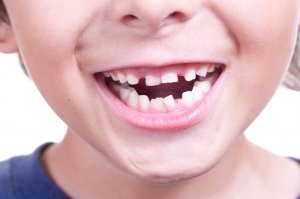
Baby teeth coming in crooked shouldn’t be an immediate cause for concern. There are various factors that can make baby teeth crooked, and it doesn’t necessarily mean that that you’ll be dealing with permanent teeth growing in crooked as well.
Research shows that the crowding of teeth can get worse as we age, just like other age-related changes — wrinkling of the skin and hair turning gray. So you may find that as you grow older, you have crowded teeth when once it wasn’t a problem.
One of the tools orthodontists have to ensure that crowding doesn’t get worse is orthodontic retainers, usually worn after orthodontic treatment with braces. These are often permanent or fixed to the backs of the teeth, so they aren’t visible, but work to keep teeth in line.
Orthodontic treatment can be a significant advance towards enhancing your dental wellbeing. Visit your orthodontist for a consultation if you or your child has crowded teeth.
Dr. Yusupov, Amazing Smiles Orthodontics
However, if baby teeth are growing in crooked because the child has inherited a small jaw from one parent and large teeth from the other, resulting in overcrowding, it’s likely they will need orthodontic work later on. If a child has gaps between their baby teeth, this is usually a good indication that they won’t suffer from overcrowding with their adult teeth.
Kids with crooked teeth will find them harder to clean than straight teeth, so you’ll need to pay special attention to your child’s oral health.
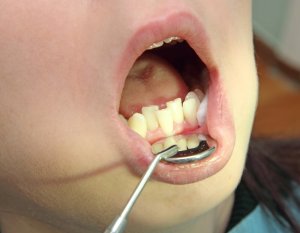
You should start taking your child to the dentist as soon as their first tooth erupts. This not only lets the dentist monitor the growth of their teeth; it also gets the child used to having dental checkups.
What to do if permanent teeth are coming in crooked
Don’t panic if your child’s permanent teeth are coming in crooked; they may well straighten themselves out as they find space to grow. However, it’s a good idea to take your child for regular dental checkups. If the dentist thinks your child may need braces for crooked teeth, they will refer you to an orthodontist for further assessment.
Our article on braces for kids has more information on how cases are assessed for Medicaid or the Children’s Healthcare Plan (CHIP) treatment eligibility. You can also check out our guide to Medicare and Medicaid dental insurance for eligibility information.
People with crooked teeth as adults
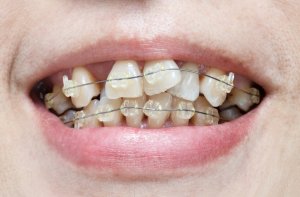
Many adults live their lives with crooked teeth and think nothing of it. Unless you have really crooked teeth, severe enough to affect your eating or speech, or it’s causing you pain of some kind, there may not be any medical need to fix it.
But of course, it’s natural to be self-conscious about a crooked teeth smile. Teeth can become more crooked over time, and it’s quite common for adults to fix their crooked teeth later in life for purely cosmetic reasons.
Do pacifiers make teeth crooked?
If you have an infant, you may be wondering if thumbsucking or pacifiers cause crooked teeth. According to the ADA, thumbsucking is a natural instinct that infants and small children have to calm themselves. However, prolonged thumbsucking and pacifier use can cause baby teeth to come in crooked, and further on, permanent teeth as well, resulting in a condition called pacifier teeth. If your child is still fingersucking or using a pacifier after four years, it’s time to wean them off.
Types of dental malocclusion
Clear aligners like Invisalign are an increasingly popular alternative to traditional metal braces. There are no brackets or wires and they should require fewer repairs and adjustments during the course of treatment than braces.
The obvious advantages to patients – especially adults – are that they are removable and less noticeable. Those perks also mean aligners are easier to clean and maintain.
Aligners may not be the best teeth-straightening solution for all orthodontic patients, however. Braces are favored in more complex situations involving severe crowding, impacted teeth, or jaw relationship correction.
Typically, the cost for aligners and braces are comparable. As with all healthcare decisions, it’s important to begin with a thorough examination and consultation with your orthodontist so that the two of you can come up with a treatment plan that makes the most sense for your individual case.
Dr. Greg Nalchajian, Nalchajian Orthodontics
Malocclusion classes
Orthodontists use the following categories to define malocclusion and separate them into malocclusion classes:
- Normal occlusion: The upper and lower first molars come together normally.
- Class 1 malocclusion: The upper and lower first molars come together normally but other teeth have some crowding, rotation or other irregularities.
- Class 2 malocclusion: The upper first molar is positioned too far forward in relation to the lower first molar (resulting in an overbite).
- Class 3 malocclusion: The upper first molar is positioned too far back in relation to the lower first molar (resulting in an underbite).
Don’t worry if these are a bit difficult to understand. There are other ways to categorize malocclusions and crooked teeth using more familiar terms. We have written detailed articles about each of these problems; click through on the links below to read more.
Overbite/deep bite/overjet
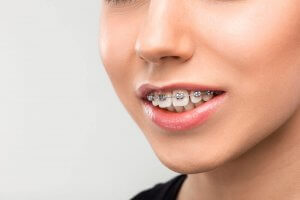
An overbite occurs when the upper front teeth overlap the bottom teeth too far horizontally (a deep bite) or when they stick out too far vertically (an overjet). This is one of the most common malocclusion types and can usually be corrected with braces.
Read more about overbite treatment options.
Underbite
With an underbite, the lower front teeth stick out further than the upper teeth. Around 5-10% of the population have an underbite, and correction is usually recommended.
Read more about underbite treatment options.
Crossbite
A crossbite occurs when the upper teeth sit inside the lower teeth. It may affect just one tooth or a whole row of teeth anywhere in the mouth. Malocclusion surgery may be necessary if the jaw is misaligned.
Read more about crossed bite treatment options.
Open bite
With open bite malocclusion, a gap remains between the upper and lower front teeth while the back teeth make contact when biting. This is usually caused by habits like thumb sucking and tongue thrusting.
Read more about open bite treatment options.
Overcrowding
Overcrowding is a common cause of crooked teeth. If there isn’t enough space in the jaw for teeth to erupt in the proper position, they end up rotating or overlapping. This can happen in either jaw, so you may end up with only crooked bottom teeth or crooked top teeth.
It’s sometimes necessary to remove one or more teeth to create enough space in the jaw. Some patients will need to get spacers for teeth before braces, to make sure there’s enough room for teeth to straighten as well.
Gaps between teeth
Even if teeth come in perfectly straight, there may be noticeable gaps between them. The technical term for a gap between two teeth is a diastema. It most commonly occurs between the two front top teeth.
Gaps between teeth can affect the esthetics of a smile, and also make it easier for food to get stuck.
Read more about fixing gaps between teeth and the types of diastema.
How to fix crooked teeth
The most common crooked teeth treatment is braces. These come in many styles (you can read more about the different types of braces in our guide here), but they all work by gradually shifting the teeth into a better alignment.
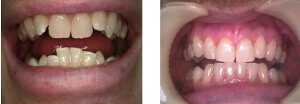
Treatment with braces on crooked teeth usually takes 12-18 months, but more severely crooked teeth cases can take longer. Some teeth may need to be filed, also called Interproximal reduction, or IPR, to create more space between teeth or to even up the edges.
If you have slightly crooked teeth, or it’s only your front teeth which need to be straightened, treatment may be quicker and cheaper. Certain brands of braces offer special crooked front teeth solutions designed just for this purpose. Other brands, like Fastbraces, offer a non-traditional (triangular) wire-and-bracket system to speed up treatment time.
Additionally, if you only have crooked bottom teeth or crooked top teeth, you may only need braces on the top or bottom.
On the other hand, if you have a severe malocclusion of teeth because of a misaligned jaw, you may need surgery in addition to braces to straighten your crooked teeth.
There is a possibility that your diastema will reopen after orthodontic treatment, if other factors like frenum anomaly or muscular habits have not been addressed.
How to fix crooked teeth without braces
If you’re interested in fixing crooked teeth without braces, you might consider treatment with removable clear aligners. This style of brace is one of the most popular alternatives to fixed braces for crooked teeth and includes the popular brands Invisalign, NewSmile, Byte and Candid. With this sort of treatment, crooked teeth can be shifted into proper alignment without it being obvious you’re undergoing orthodontic work. Many patients, especially adults, appreciate being able to remove their braces for several hours per day, too.
In-office solutions like Invisalign can work out more expensive than traditional metal braces for crooked teeth, but did you know there are cheaper options in the form of at-home aligner treatment? These let you carry out your treatment 100% remotely, making them more convenient and cost-effective.
If you’re interested in treating your crooked teeth at home with aligners, you can check out the best options available below:
- Most affordable options
- Single and dual arch, day and night options
- Convenient AlignerTracker app
- Free teeth whitening
Aligner32 offers a convenient and affordable way for individuals to straighten their teeth using custom-fit clear aligners. Their service is designed for at-home use, allowing customers to avoid frequent orthodontist visits while still achieving professional-grade results.
Aligner32 provides two main treatment plans tailored to suit different needs:
- All-Day Plan: The All-Day Plan requires 22 hours of daily wear and offers faster results, with treatment lasting between 4 to 6 months.
- Night Wear Plan: The Night Wear Plan is ideal for those who prefer a more flexible routine, requiring just 10 hours of daily wear, typically at night, with a treatment duration of 6 to 8 months.
Both plans are designed to treat a range of orthodontic issues, including crowding, spacing, overbites, underbites, and crossbites.
With affordability in mind, Aligner32’s clear aligners are significantly less expensive than traditional braces, which can cost between $5,000 to $8,000. Customers can also use flexible payment plans, making it easier to manage the cost.
Additionally, Aligner32 offers a free teeth whitening kit with their aligner packages, making the treatment even more appealing. The company emphasizes comfort, convenience, and professional care, making it a popular choice for those seeking a better smile without the high costs and hassle of conventional orthodontic treatments.
- Complete treatment 100% remotely
- Amazing customer service
- Nighttime-only option
- $1,495 or $55/month
NewSmile aligners are made from the clearest Essix plastic and come with a daytime or nighttime-only option to suit you. For just $1,495 you’ll receive everything you need to straighten and whiten your teeth – and maintain your new smile:
- Home impression kit
- Full aligner treatment
- Free whitening
- First set of retainers
- A full refund if you’re not a good fit
NewSmile goes above and beyond to provide a great experience to all their customers, beginning with a live video call to help you with your teeth impressions. Mail these back, and they’ll send a 3D Treatment Preview for you to approve before going ahead.
- Smileie Pro offers hybrid treatment!
- Single-arch treatment option
- Nighttime aligners available
- Free refinements & 2 sets of retainers
- $699 (single-arch) or $999 (dual-arch)
Smileie’s aligner treatment is not only affordable, but flexible too. You have the option of Smileie Pro, which is hybrid treatment that involves in-office visits with a dentist.
That means more accurate, safer and effective treatment or a wider variety of cases.
But you can also opt for single-arch treatment for just your top or bottom teeth, as well as nighttime-only treatment. And whichever package you choose, monthly payments are available.
On top of this, Smileie offers a 100% satisfaction guarantee which includes free refinements if needed. Their aligners are made in the US and treatment takes 4-6 months on average.
Get Smileie Pro for just $1499, or —
Get the best discount on the standard plan, with 100% remote treatment, when you purchase your aligner package up-front, including:
- Home impression kit
- Teeth whitening kit
- Two sets of retainers
- A full refund if you’re not a good candidate
Packages start at $699 for single-arch treatment. Click below to check for current discounts!
- Complete treatment 100% remotely
- 4-6 month average treatment time
- Nighttime-only option
- $770 or $64/month
If you’re looking for the best value aligner package, here it is! For just $895 you’ll get:
- Impression kit
- Full aligner treatment course
- Free teeth whitening kit
- Your first set of retainers
In short, everything needed to straighten your teeth remotely and keep them looking great, with a full money-back guarantee if you’re not a suitable candidate.
This low price doesn’t mean you’re compromising on quality of care, though. ALIGNERCO just choose not to put so much into marketing, and they pass on the savings to their customers. They are also known for their responsive and helpful customer care, which is important when you’re doing things from home.
Nighttime-only aligners are also available for anyone who doesn’t want to wear aligners during the day.
Can retainers fix crooked teeth?
Another possible way to straighten crooked teeth without braces is with a retainer. Retainers for crooked teeth don’t have the same force as braces, so can only be used in mild cases. You’ll also need to wear a retainer to avoid getting crooked teeth again after braces.
In some instances, like with crooked wisdom teeth, braces may not be needed as extraction may be the best option.
Veneers for crooked teeth in adults
You may be wondering if veneers can fix crooked teeth and if you can get veneers with crooked teeth. Veneers are a type of cosmetic dentistry for crooked teeth which can be used in mild cases of misalignment to improve the appearance of the teeth. Rather than changing the position of the teeth, a dentist can place veneers on crooked teeth to make them look straighter.
Additionally, if your teeth are still crooked after braces, porcelain veneers make be a good finishing touch for crooked teeth, especially veneers for crooked front teeth.
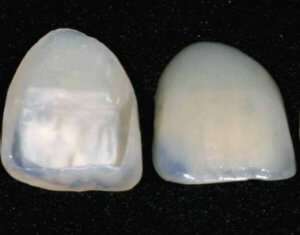
These tooth coverings can be applied directly using composite material, or made to measure from porcelain. Composite veneers for crooked teeth cost $250 – $1,200 per tooth while porcelain veneers cost between $500 – $2,500 each. If you’re thinking about fixing crooked teeth with veneers, you can read more about this treatment and see images of crooked teeth before and after veneers here.
Bear in mind that you can only use veneers for crooked front teeth, and they aren’t suitable for all malocclusion cases. The original teeth will need to be filed down slightly, meaning you can’t simply remove the veneers when they fail. You’ll need to get new veneers or crowns to cover the teeth again.
Dental bonding is another option for crooked teeth. Tooth bonding is similar to veneers, but is a less complicated procedure and thus less expensive.
Can you fix crooked teeth at home?
You may have heard of or seen people offering ways to fix crooked teeth at home. Although the cost savings may be appealing, you should always seek treatment from a professional. Avoid DIY options, but yes, there is a way to get treatment without ever leaving your home with at-home aligners.
Summary of malocclusion treatments
The table below shows the possible ways to fix crooked teeth, according to the type of malocclusion. The most suitable treatment for you will depend on a number of factors, so follow your dentist’s advice.
Braces (including invisible aligners)? | Surgery (in severe cases)? | Veneers? | |
Overbite | Yes | Yes | No |
Underbite | Yes | Yes | No |
Crossbite | Yes | Yes | No |
Open bite | Yes | Yes (more likely for adults) | Yes |
Overcrowding | Yes | No | Yes |
Gaps between teeth | Yes | No | Yes |
Conclusion
So now you know why teeth grow crooked and how to straighten crooked teeth. Whatever type of malocclusion you have, the good news is that you don’t have to live with crooked teeth and all the problems they bring.
There are various treatments which can improve your bite, the appearance of your teeth, or both. Options include braces, veneers and surgery, depending on the severity of the misalignment. Your dentist will be able to advise you on the treatment that would suit you best.
SlideShare: Classification of malocclusion. Consulted 1st June 2019.
ADA: Thumb sucking and pacifier use Consulted 20, June 2019.
Invisalign: Before and After Consulted 20, June 2019.








